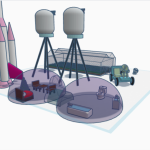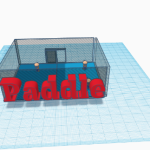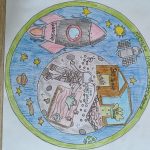Space colonization by earthlings of Europa (Jupiter’s moon) by SPCLMoons
Dnipro Lyceum 31 “Priority” of the Dnipro City Council Dnipro-Dnipropetrovsk region Ukraine 16 years old, 17 years old 6 / 2 English Jupiter’s moons
Project description
SPCLMoons – space colonists of moons
Project idea: collect materials and provide a detailed description of the research mission to find places for life on the moons of Jupiter, separately – in the ocean of Europe; also inform earthlings about this satellite and interesting facts about it; develop a physical model of the satellite; develop a team flight animation for the main mission. Team name SPCLMoons (space colonists of moons).
The goal of the educational project is to deepen our knowledge about space Europa as a potentially viable satellite of Jupiter, as well as to develop technologies and methods of space exploration for future missions, to reveal key and scientifically important aspects of this object of the Solar System.
The main tasks of our project:
1. The search for living conditions is the main task: identifying the conditions and opportunities for the existence of life in Europe. The initial steps of the research are the search for organic substances, the analysis of the composition of the surface and the possibility of the existence of an ocean under the ice sheet.
2. Study of geological processes: understanding the geological structure of the moon, studying rock formations, craters, sinkholes and other geological structures, which will help to clarify the nature and history of the satellite.
3. Analysis of the atmosphere and climate: the study of the chemical composition of the atmosphere, climatic conditions, interaction with Jupiter’s magnetosphere and other factors that affect conditions on the surface.
4. Technology development: using the mission to improve and develop new technologies for space exploration that are based on the application of advanced scientific discoveries, especially robotics and other tools.
5. Increasing our knowledge of the space environment: obtaining data from reliable sources about radiation conditions, the magnetosphere, electromagnetic fields, and other parameters that affect space travel and extraterrestrial life.
The exploratory expedition to Jupiter’s moon Europa is an exciting and important scientific mission. Europa is considered one of the most interesting objects in the Solar System for research due to the possible presence of an ocean beneath its ice cover and potentially habitable conditions.
The main goals of the research expedition to Europe:
1. Research of the geological structure: study of the ice cover, geological formations, phenomena that testify to active processes on the surface.
2. Search for signs of the ocean: detection of possible traces of water under the ice sheet, study of the chemical composition and other characteristics indicating the presence of the ocean.
3. Atmospheric research: analysis of the composition and properties of Europe’s atmosphere, which will help to understand the climatic conditions and the possibilities of life.
4. Searching for organic matter: analyzing samples to identify organic compounds that may indicate the potential presence or past existence of life.
5. Technological research: development of new technologies for space exploration and use of the planet’s resources.
An expedition to Europe involves a high level of technological complexity, financial and economic cooperation between different countries and leading scientific institutions. Such an expedition can significantly expand our knowledge of extraterrestrial environments and influence the further development of space research.
Project link
https://drive.google.com/file/d/1UbWGpQwZxa570Zc_9v7pbC3DTRP4wpJe/view?usp=sharing
Project video
#
Arts & Crafts #
Other
Other Projects
Base Espacial con tinkercad
Alcalá de Guadaira – Spain
















